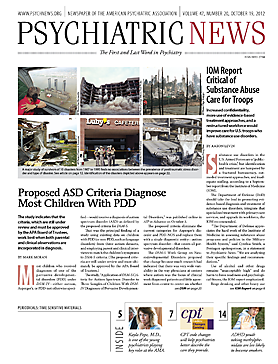“There’s no such thing as a bad boy.”
So said Father Edward Flanagan, played by Spencer Tracy, to the delinquent Whitey Marsh (Mickey Rooney) in the 1938 Hollywood classic “Boys Town.”
The movie about the internationally known home for emotionally and mentally disturbed youth helped immortalize Boys Town and Flanagan, its founder, whose actual words (according to the Boys Town Web site) were “There are no bad boys. There is only bad environment, bad training, bad example, bad thinking.”
Today, Boys Town, located in Boys Town, Neb., is still refusing to give up on troubled children—both boys and girls now—and its mission is being given what might be called a biopsychosocial update. In January, child psychiatrist Kayla Pope, M.D., an activist physician who is emerging as one of psychiatry’s new young leaders at the AMA House of Delegates, was named director of neurobehavioral research at the Boys Town National Research Hospital, which opened in 1977.
In an interview with Psychiatric News, Pope talked about her work on behalf of psychiatry at the AMA and about her new endeavor at Boys Town.
She said the new Boys Town research division is designed to gain knowledge about which interventions provide the best outcomes for children with behavioral and mental health problems. “Once established, the program will become an active partner with researchers both locally and nationally to develop the evidence base for best practices to treat behavioral and mental health problems in children and to promote the adoption of these practices,” she said.
Pope said goals include evaluating the trajectory of illness across development in different diagnostic categories and the impact of intervention at different developmental stages; development of novel therapeutics (including music therapy and use of virtual-reality computer programs); research on the effects of trauma and biological and environmental factors that influence resilience; and research on attachment, including genetic markers (oxytocin, vasopressin, and the mu-opioid system) that appear to correlate with increased risk for aggression and disruptive behavior.
“Neuroscience has brought us to the point where we have good biomarkers for many of the disorders we see in childhood,” Pope said. “So it puts us in a place where we can begin to look at interventions on the biological level, rather than evaluating their effectiveness by behavioral observation only.”
Wanting to ‘Change the World’
Pope brings to her new position the vision and idealism that has also guided her involvement in organized medicine. As the delegate from the American Academy of Child and Adolescent Psychiatry (AACAP) to the Young Physician Section of the AMA’s House of Delegates, she is one of a cadre of young psychiatrists who are energizing the AMA and helping to build connections between psychiatry and the rest of medicine.
“I have always been interested in communicating across specialties,” she noted. “I think there is a lot we can learn from other specialties, and a lot they can learn from us.”
Pope was recruited to the AMA by mentors at AACAP as a delegate to the Resident and Fellow Section, an experience that was invigorating and kindled an interest in the way organized medicine could shape residency education. “The other resident delegates were so passionate and so collaborative,” she said. “And they wanted to change the world.”
She served for a period as a representative to the Accreditation Council for Graduate Medical Education’s Residency Review Committee for psychiatry and as APA’s member-in-training trustee.
At the AMA’s House of Delegates, Pope has testified on issues such as the shortage of child psychiatrists and health care reform. And in a column in Psychiatric News, she made a pitch for APA members to join the AMA. “As the only organization in which all of medicine speaks with one voice, the AMA is the strongest advocate for improving the quality of our training, our lives, and our careers,” she wrote. “When you join the AMA, we as psychiatrists get more representation and a stronger ability to carry your issues forward.”
Her presence at the AMA is also evidence of one of the most striking changes in recent years in the demographic makeup of the AMA house. Today, nearly 20 percent of AMA delegates and alternate delegates are women, compared with 1983, when just 1.8 percent of delegates and 3.0 percent of alternate delegates were women. And among resident and early career physicians, the prominence of women is even more pronounced (see Psychiatrist Works to Ensure Women Physicians Get Recognition).
That growth is reflective of the changing face of American medicine generally. The AMA reports that among all physicians in the United States (not just AMA members) the percentage of women doctors has grown a staggering 447 percent since 1980. Moreover, nearly half of medical students in 2011–2012 were women, compared with 31 percent in 1982–1983.
‘This Is Not Your Parents’ AMA’
Carolyn Robinowitz, M.D., chair of the APA Section Council on Psychiatry and a past APA president who has been involved at the House of Delegates since the late 1970s, remarked on the changing face of the AMA. “When I first attended the AMA House of Delegates meeting in 1977, I was one of very few women physicians in attendance, and we all knew each other,” Robinowitz recalled. “The past 35 years has brought a welcome increase in diversity at all levels. This is not your parents’ AMA.”
She added, “Kayla’s effectiveness in the House of Delegates is another indication of the respect psychiatry has gained at AMA over the last decade, and her participation has had an impact on our medical colleagues’ understanding and support of the importance of psychiatric care.”
Pope came to Boys Town from Washington, D.C., where she was a fellow at the National Institute of Mental Health (NIMH) working on imaging research on conduct disorder in children. Leadership at Boys Town (which has long had a nonpharmacologic approach to conduct and other disorders in children) approached NIMH leadership seeking ways to collaborate, and a project was initiated to develop a research protocol to determine whether—from a neurobiological perspective—the use of antipsychotics in children is warranted.
“After three or four visits to Omaha, the director of Boys Town approached me about starting up a research division,” Pope explained. “The more I thought about it, the more I thought this was an incredible opportunity.”
Boys Town serves 900 boys and girls on its Omaha campus who require a highly structured environment and who live with a family in “treatment family homes.” It also provides services to the greater Omaha community and at sites across the country.
So does today’s Boys Town still operate on the principle that “there is no such thing as a bad boy (or girl”)?
“It does,” says Pope, who noted that “graduates” of Boys Town typically enter the community with jobs in the private sector or the military and that the center boasts a very low rate of recidivism.
“Boys Town is really committed to a model of behavior modification and to the idea that by teaching children how to behave, they will respond and become productive members of the larger community,” she said.



